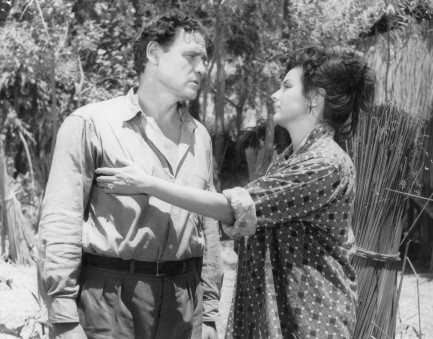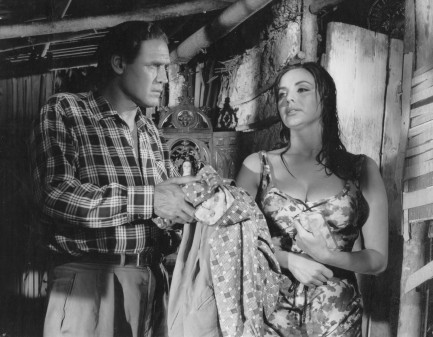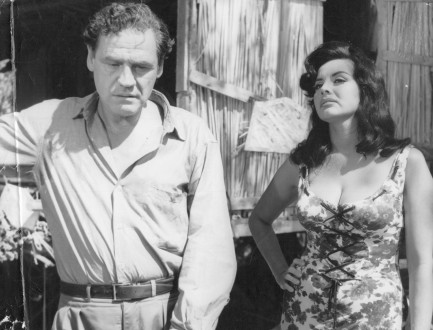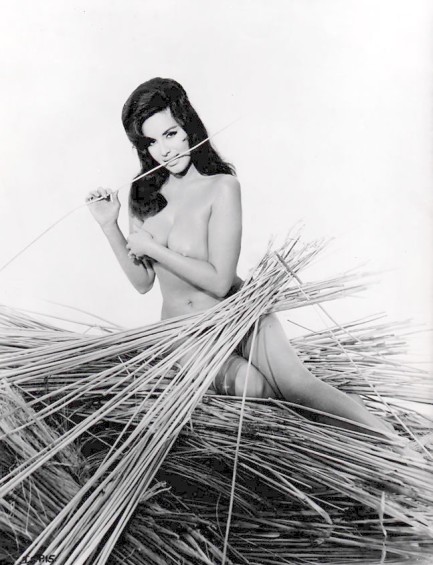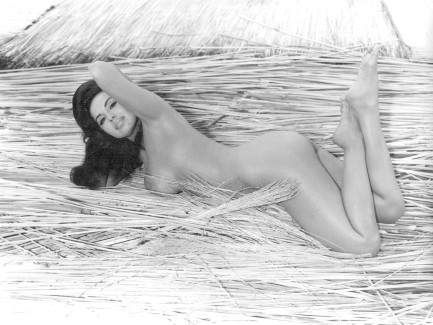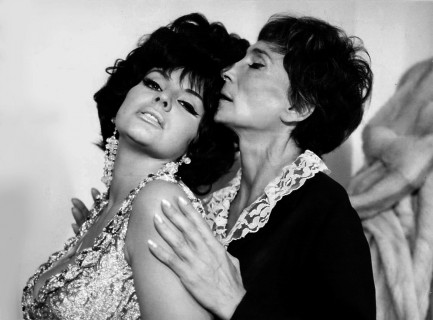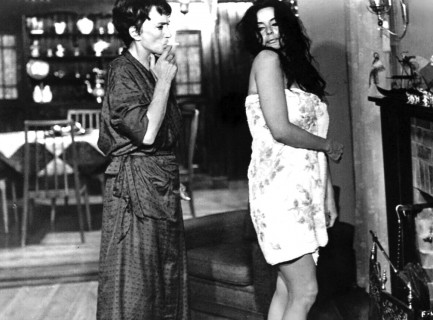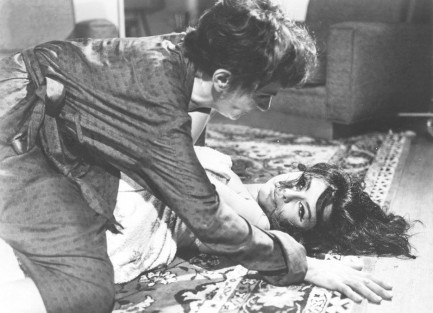 When Isabel Sarli enters paradise the snakes come crawling. 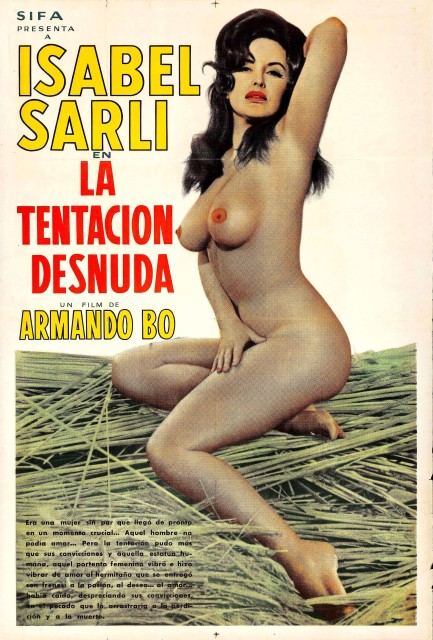
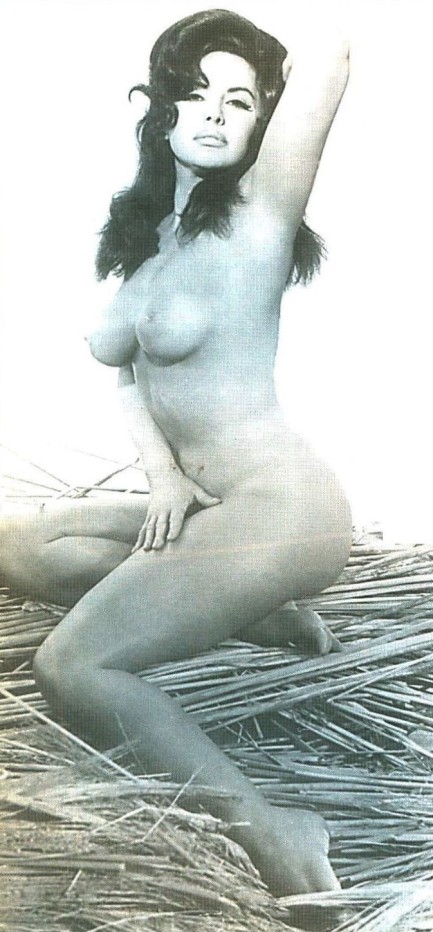 We often describe posters in glowing terms but this effort for the Argentinian sexploitation drama La tentación desnuda is a legit stunner. The movie, which starred international sex symbol Isabel Sarli, premiered today in 1966, and in that year we can't imagine where this provocative promo was displayed. If anywhere. We often describe posters in glowing terms but this effort for the Argentinian sexploitation drama La tentación desnuda is a legit stunner. The movie, which starred international sex symbol Isabel Sarli, premiered today in 1966, and in that year we can't imagine where this provocative promo was displayed. If anywhere.
At first we thought it was a recently made fan creation, but we changed our minds. The fold lines look real, and while those can be created in Photoshop, fan art is almost always too lazy for such touches. Sarli's breasts don't look quite like in real life because the designer painted on a pair of weird cherry nipples, but we've seen that happen with posters before. Otherwise the art matches perfectly a promo shot made by photographer Olga Masa for the movie, but at a much higher resolution.
La tentación desnuda delivers in melodramatic but engrossing style exactly what the title suggests, and shows yet again why Sarli was such a massive star. Plotwise she falls off a boat, drags herself from the water, and wanders blindly to hermit Armando Bo's riverside shack, where she's given shelter and food. Bo harvests sugar cane and hangs out playing his harp, trying to find, “freedom, to be absolutely free,” and to “live spiritually, near the river, the trees, the birds,” but Sarli laughingly upsets his singular existence in a big way by questioning his beliefs and showing lots of skin. She sticks around when Bo promises to demonstrate the merits of his ascetic lifestyle, but other men who live and work on the river have different ideas for Sarli—and they don't involve holistic simplicity.
If the plot seems very similar to 1953's La red you'd be right. Femmes fatales bringing chaos to edenic enclaves was a popular theme in Latin American cinema. This iteration, for the year it was released, is very daring, yet another example of what was going on outside the censored environment within the U.S., where motion picture themes were constrained by the Production Code. Meanwhile, in militarily ruled Argentina, Sarli was going fully nude—a few times, in the case of this film. We guess Juan Carlos Onganía and company liked a litle skin. Even dictators get boners.
Sarli may embody tentación, but she doesn't try to tempt the men around her, aside from Bo, who's the only one she wants. But her preferences mean nothing. Soon everyone is fighting over her, hauling her around like hand luggage on a commuter flight. She's even worth torturing and killing over, as things develop. Men, right? But they'll pay for their hubris. And because Biblical metaphor is strong with this film, there's even a bit of mysticism involved. Maybe that's why the dictatorship tolerated it—that type likes hamhanded religious tropes even more than boners. Well, we'll tolerate Sarli anytime too. You'll be seeing her again.
 Isabel Sarli is too hot to handle. 
Fuego is a movie from Argentina but we were so taken with this Japanese poster that we decided on it over the original promo art. The colors laid atop the black and white background are nice. As for the movie, which originally premiered in 1969 and reached Japan today in 1971, it's a bizarre sexploitation flick about Isabel Sarli and her servant Alba Mujica, who carry on a lustful lesbian affair while Sarli is simultaneously pursued by local alpha male Armando Bo. The triangle is complicated by the fact that Sarli has a little problem: she wants sex so much she doesn't care where, when, or from whom she gets it. The movie's theme song tells the story:
Fuego en tu boca, Fuego en tu cuerpo, Fuego en tu sangre, En tus entrañas, Que queman mi alma, Mi amor.
Fire in your mouth, Fire in your body, Fire in your blood, In your guts (eww), or alternatively, bowels (eew) That burns my soul, My love.
It's a good thing Sarli has fire in her blood, because she makes love in the snow. No blanket under her or anything. She's so overheated she goes around her provincial Patagonian town randomly flashing men. She's so inflamed she even squirms and moans when she sleeps. “I don't know if I'm fickle or wicked,” she muses. Her problem is neither. It's really that she's hostage to a cheeseball sexploitation script. She tells her suitor Bo she'll be unfaithful if they marry, but he doesn't care. “I want to be good,” Sarli says. Mission unaccomplished. As her doctor explains, her condition is caused by sexual neurosis. “A neurosis that is particularly manifested in the genitals.”
Okay then. It's unsurprising that the quack doctor next takes a comprehensive feel around Sarli's vagina. But no cure is to be found, there or anywhere, and her condition continues to consume her. Bo (who wrote and directed, as well as did most of the boob kissing) presents her narratively as an almost cursed figure, a kind of tragic sex goddess of the Andes. But even so, the movie is no more than a bad South American soap opera. Or really, even a classical opera—it needs only an aria to complete its ascent up majestic Mount Melodrama. Sarli is a legendary sex symbol in South America and she shows why, over and over, but in the final analysis we can't recommend Fuego. However, we doubt we'll ever forget it.
 Anything could happen there and it usually did. 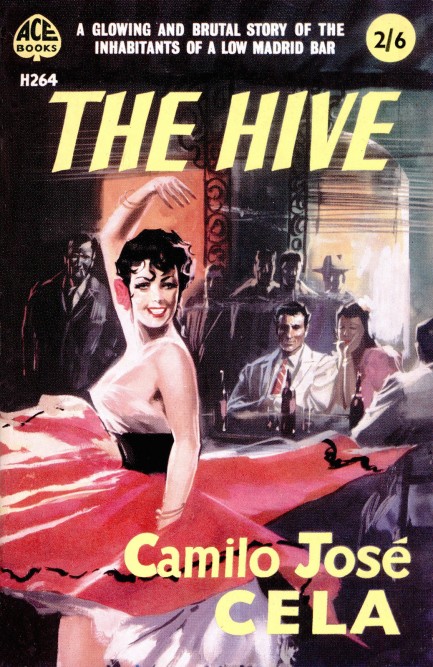
We're drawn to books about places we know, so Camilo José Cela's The Hive was a natural. Originally published in 1950 and titled La colmena, the tale is largely set in a Madrid bar known as Doña Rosa's Café. There are also scenes set in apartments, streets, and other cafés, as Cela explores the lives of more than three-hundred characters in brief sketches, slowly weaving these warp and weft strands into a tapestry that ultimately represents a single character—Madrid circa 1943. Maybe that doesn't sound thrilling, but we liked it. Cela was economical yet vivid, like here, at closing time for the café:
Within half an hour the café will be empty. It will be like a man who has suddenly lost his memory.
And here, about a boy who survives by singing on the street:
He is too young in years for cynicism—or resignation—to have slashed its mark across his face, and therefore it has a beautiful, candid stupidity, the expression of one who understands nothing of anything that happens. For [him] everything that happens is a miracle: he was born by a miracle, he eats by a miracle, has lived by a miracle, and has the strength to sing by pure miracle.
Cela was a fascist, a supporter of Francisco Franco's dictatorship. His beliefs came with contradictions, for example he worked as a censor for the government, was himself banned so that The Hive had to be published first in Argentina, yet remained loyal to the regime that had financially and reputationally harmed him. He even became an informer. In Cela's writing there's humor, but also coldness, a sense of observing small and pathetic people. For someone born into material comfort in a Spain where many families retain unearned wealth for hundreds of years, his subtle judgements came across to us as cruel, the product of a person who looked closely at everyone but himself. The book isn't overtly political, though, which makes it easier to focus on the skill that eventually won him a Nobel Prize.
The edition you see here is from Ace Books in 1959 with an uncredited cover. We went back and forth on this artist. We want to say it's Sandro Symeoni, but we don't have enough cred to make that call definitively. It looks like some of the items he painted, but publishing companies sometimes sought art of similar styles, or directed illustrators to produce something similar to what another artist had provided. During the late 1950s and early ’60s Ace Books had many covers in this general style. That said, compare the close-ups below. The first is from the above cover, and the rest are from confirmed Symeonis. If The Hive wasn't painted by the same person, then whoever did paint it went beyond merely working in a similar style—he was a thief. 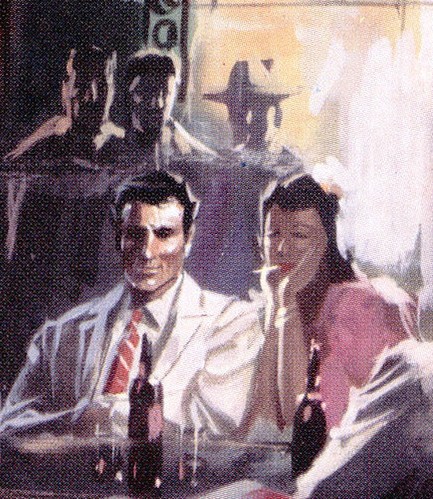 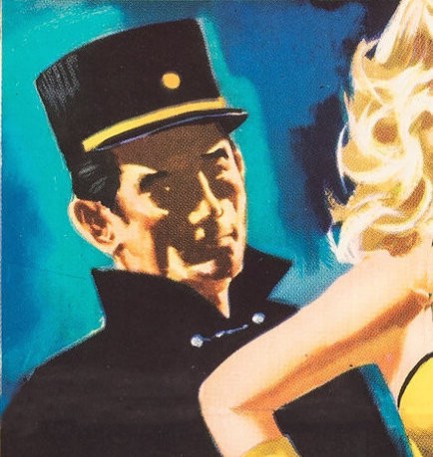 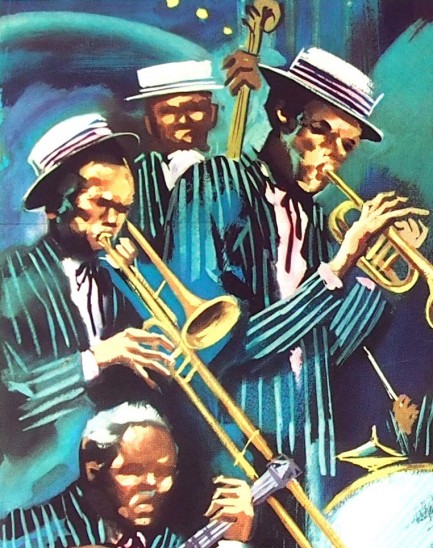 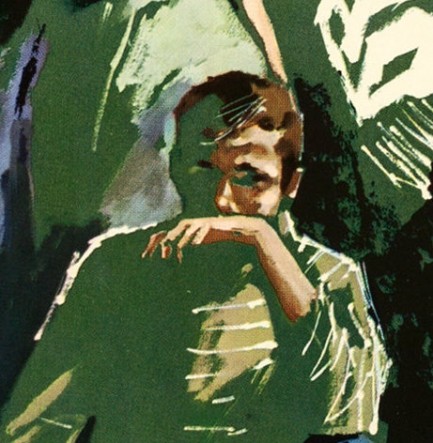 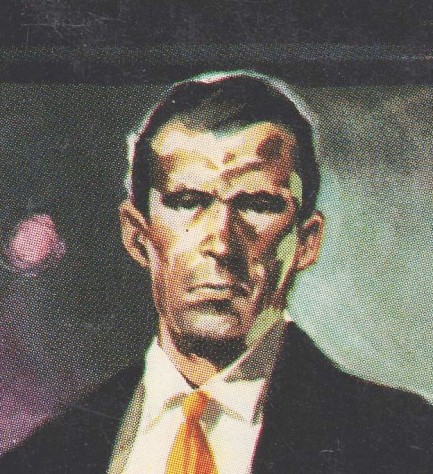
 Excuse me madam, would you like to hear an American's opinions about everything? 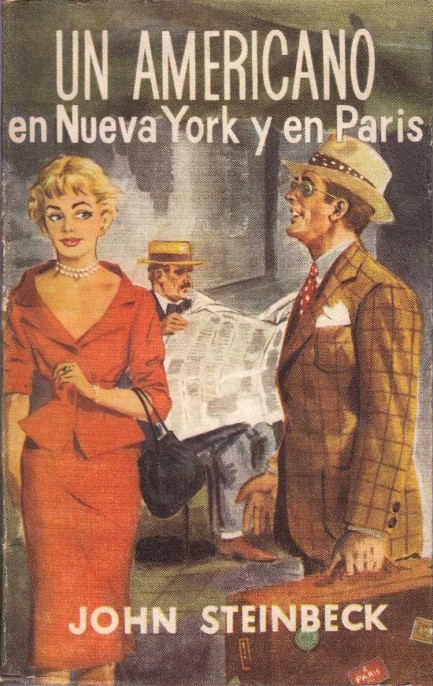
John Steinbeck's Un americano en Nueva York y en Paris was published in 1957 by Ediciones Mariel, which was based in Buenos Aires. First published in 1956 in France as Un Américain à New York et à Paris, this is a collection of articles that Steinbeck wrote for Le Figaro when he was living in Paris. Because they originally appeared in French for a French publication many went unpublished in English for decades. In fact we can't be sure all the essays are available in English even today, though one would like to assume so. In any case, that's why this book caught our eye—because it surprised us that the entire collection of essays was available in Argentina, but not the U.S., almost immediately after they appeared in France.
Steinbeck was a serious writer, and thus was considered a serious persona, but the Le Figaro essays gave him a chance to show readers his wit and humor. Some of his observations read so contemporarily they could be from a year ago, particularly his musings over a restaurant owner who received a Michelin star, then spent every waking moment plotting, hoping, suffering to get another. He hopes to have his chance when the Michelin critic schedules another visit. The fact that the chef's official taster is Steinbeck's cat Apollo just adds more absurdity to the tale, as the genius who wrote Of Mice and Men veers into the silliness of cats and menus.
The parts of Un americano en Nueva York y en Paris not about France consist of articles concerning New York, culture, and politics. One of those latter entries, from 1954, is about Joseph McCarthy, who was in full witch hunt mode at the time. Much of the literati were loudly opposed to the proto-fascist senator, but Steinbeck took a different tack, writing that democracies occasionally need a challenge from demagogues in order to evolve, because such dark episodes remind people what democratic ideals really are—i.e. everyone gets to participate, not just self-appointed gatekeepers and purity-testers afraid of change or losing power. The tent of democracy always gets bigger, not smaller. It can't do the latter and qualify as a democracy.
The cover art on this was painted by J.C. Cotignola, whose work appeared on various Argentine and Brazilian publications, but who isn't well known today. Bang up job though. To us the title of the collection somewhat echoes George Orwell's acclaimed Down and Out in Paris and London, another book about knocking around in a couple of big cities. The difference is Orwell was so poor he almost starved to death—he literally ate moldy bread out of garbage cans to survive. Steinbeck was the toast of Paris when he was there. Given a choice, we'd skip the mold and go straight to the toast. Preferably with a layer of rillette de porc on top. Even Apollo the cat would approve of that.
 There are worse fates than being Shanghaied by Hayworth. 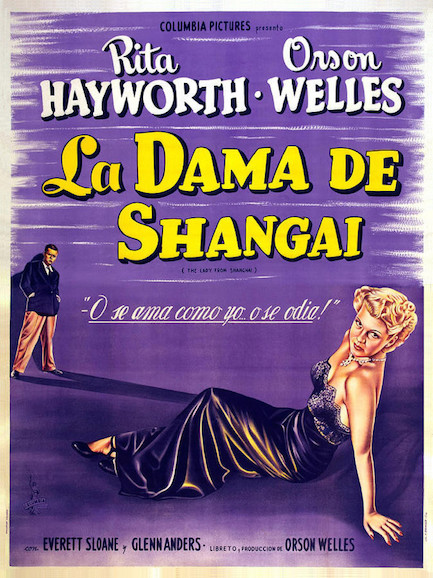
This beautiful poster was made for Argentina to promote the film noir The Lady from Shanghai, which starred Rita Hayworth and Orson Welles. There's no official Argentine premiere date, but since the movie reached Mexico in April 1948 and Uruguay in July 1948, it's a reasonable bet that it hit Argentina sometime during the summer of that year. Read a bit about the film here.
 Rita Hayworth does tall, dark, and treacherous. 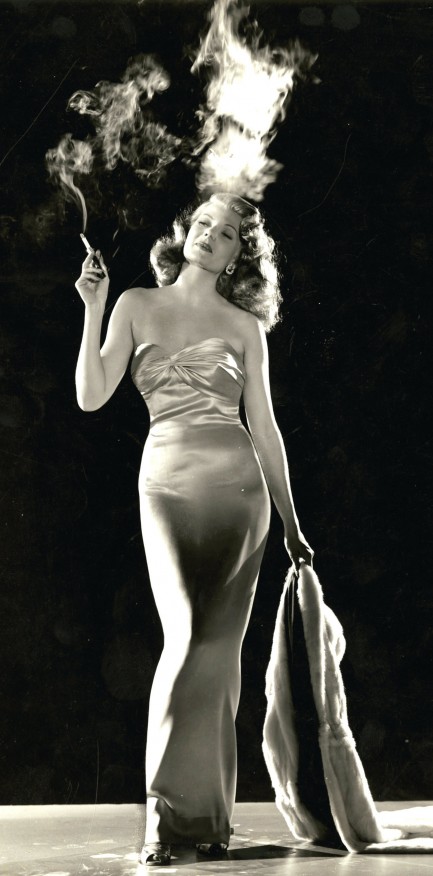
We've done a lot on Gilda, but it's one of our favorite movies of the 1940s, and we'd be remiss if we didn't show you this beautiful promo image, basically the best of the lot from this flick. Gilda had everything—an exotic Argentine location (shot on a backlot), a story of danger (done many times before), and a tough, cynical leading man (nothing new for the time period). So then, what made Gilda great, if it was so derivative? Two things—Hayworth, playing a jaded and suspicious femme fatale; and a good script that skirted that bounds of what was allowable in terms of expressing feminine sexual liberation. Co-star Glenn Ford had perfect chemistry with Hayworth, too, which counts for something, but any man would have that. No, it's Rita's show. And though she didn't live forever, Gilda will. Or at least, it'll live as long as humans watch anything that can be classified as cinema.
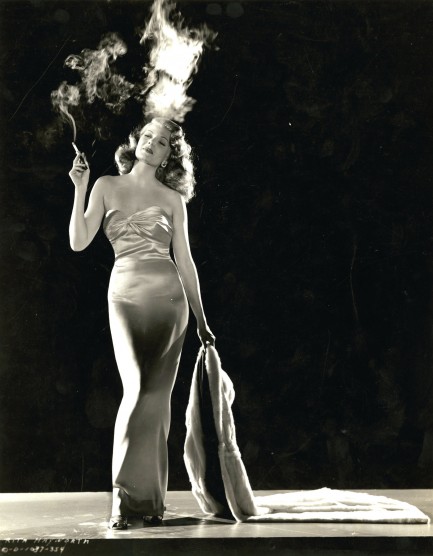
 Sometimes the end of the line can be a new beginning. 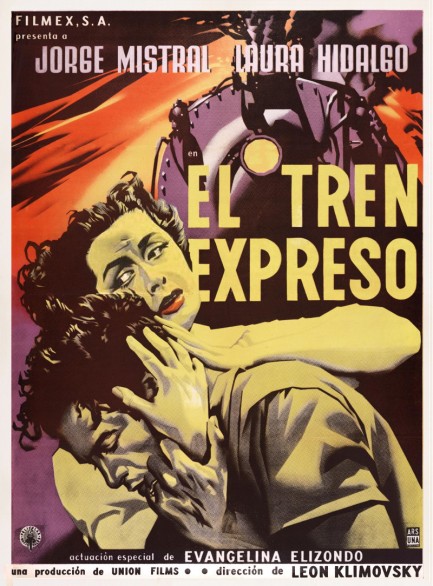
Check out this beautiful Mexican promo poster for the melodrama El tren expreso. It can be difficult sometimes to determine provenance for Spanish language items, but we know this piece is Mexican because it says Filmex, S.A. at upper left, telling us it was printed for Mexico's Cinematográfica Filmex. But the movie was originally shot in Europe with mainly Spanish participation, including from director León Klimovsky, who was Argentinian but after 1950 emigrated to and worked mostly in Spain. We watched the movie and it deals with a burned out concert pianist who takes a sabbatical and while on a train journey stops an unhappy widow from leaping to her death. These two broken souls travel together and fall in love, but matters of the heart are never simple in cinema. If you want to see the movie you can watch it at this link, but keep in mind we described it as a melodrama advisedly. Also you'll need to understand Spanish. Anyway we're mainly interested in the poster, which is amazing, but uncredited. We hit the internet for info and drew blanks for days. We eventually learned it's part of a collection at the Boston Museum of Fine Arts, but it was listed as by an unknown artist there too. So that settles it, pretty much, if professional art curators have no information. The world may never know who painted this masterpiece. El tren expreso premiered in Spain today in 1955.
 When you can move like Astaire, nobody is out of your league. 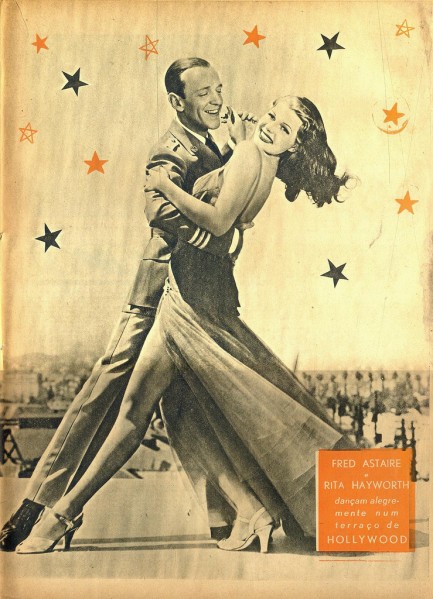
Only in the movies could a 150 pound broomstick like Fred Astaire score a babe like Rita Hayworth. Or maybe we're not giving him enough credit. He was an amazing dancer, and we know that counts for a lot. Also, Hayworth made it with Sinatra and he was tiny too. So forget what we said. She liked them small. Anyway, the image above is from the rear of a copy of the Portuguese newspaper O Século Ilustrado, and it's a promo for the musical romance You Were Never Lovelier. We've watched it a couple of times, and it's a nice flick set in Buenos Aires telling the story of a very picky Hayworth refusing to marry any of the many handsome and rich men around her. When she meets Astaire she thinks he's a pest—until she sees him glide around the room. We recommend the movie. It's as fun as this photo makes it look. To add to the fun even more, we have a promo image from the film below, and by the way, let's never forget that Hayworth was a professional level dancer too. Check here for proof. 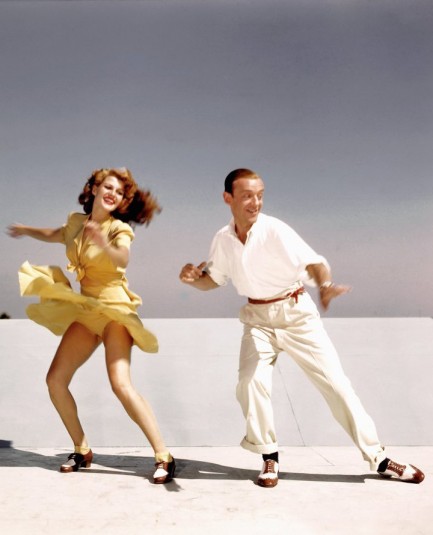
 Murder comes a-creeping. 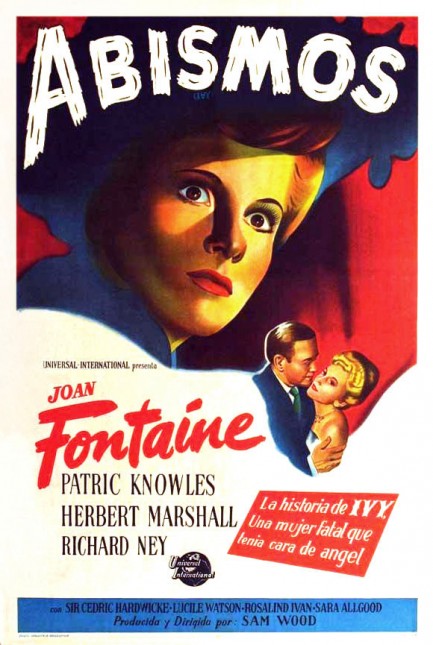
A little something from Argentina today, a poster for Abismos, which was originally released in the U.S. in 1947 as Ivy. Most sources list the movie as a film noir, but it's also an Edwardian costume drama, which is a detail you'll want to know going in. Basically, what you get here is a woman in a love triangle whose husband dies under suspicious circumstances, prompting a police investigation of her lover. Joan Fontaine plays the eponymous lead character and does a bang-up job, which is no surprise for such an acclaimed performer. Her Ivy is nervous, elusive, and frustratingly indecisive—or is she? Strong noir elements accumulate as the movie progresses and the ending is a classic exclamation point. Well worth the time spent.
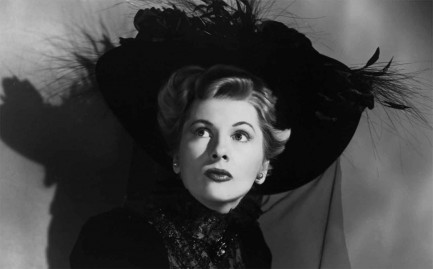
 Revenge is never as uncomplicated it sounds. 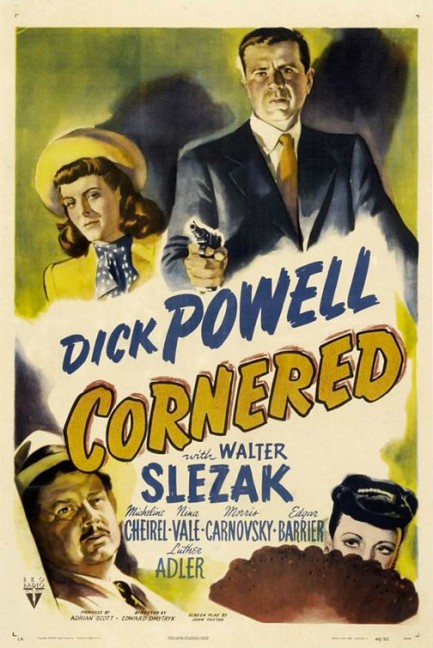
A post on Christmas? Don't we ever quit? Well, we wrote some in advance and are allowing our Pulpbot to do the posting. We're actually on a tropical island with the Pulp Intl. girlfriends and have been for several days. But if we were watching the 1945 film noir Cornered it would not be a terrible misuse of time by any means. The movie deals with a war vet seeking revenge for the death of his wife, a member of the French resistance who was killed by French collaborators. While stalking them from Europe to South America he finds himself involved in a hunt for an entire cabal of traitors still up to their scheming ways. Motivations are murky all around, but the hero is hellbent on revenge—even if it upsets the delicate plans of a group of Nazi hunters. Reasonably solid film noir, with reasonably solid Dick Powell in the lead. Cornered premiered in the U.S. today in 1945.
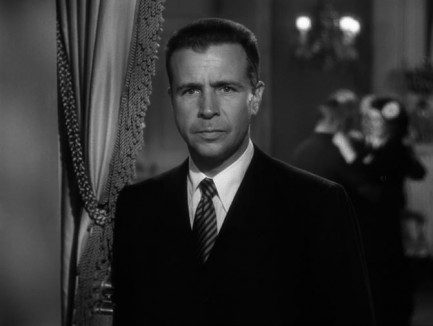
This is going to be the most awesome revenge ever. 
What the fuck have I gotten myself into?

|
 |

The headlines that mattered yesteryear.
2003—Hope Dies
Film legend Bob Hope dies of pneumonia two months after celebrating his 100th birthday. 1945—Churchill Given the Sack
In spite of admiring Winston Churchill as a great wartime leader, Britons elect
Clement Attlee the nation's new prime minister in a sweeping victory for the Labour Party over the Conservatives. 1952—Evita Peron Dies
Eva Duarte de Peron, aka Evita, wife of the president of the Argentine Republic, dies from cancer at age 33. Evita had brought the working classes into a position of political power never witnessed before, but was hated by the nation's powerful military class. She is lain to rest in Milan, Italy in a secret grave under a nun's name, but is eventually returned to Argentina for reburial beside her husband in 1974. 1943—Mussolini Calls It Quits
Italian dictator Benito Mussolini steps down as head of the armed forces and the government. It soon becomes clear that Il Duce did not relinquish power voluntarily, but was forced to resign after former Fascist colleagues turned against him. He is later installed by Germany as leader of the Italian Social Republic in the north of the country, but is killed by partisans in 1945.
|

|
|

It's easy. We have an uploader that makes it a snap. Use it to submit your art, text, header, and subhead. Your post can be funny, serious, or anything in between, as long as it's vintage pulp. You'll get a byline and experience the fleeting pride of free authorship. We'll edit your post for typos, but the rest is up to you. Click here to give us your best shot.

|
|


 We often describe posters in glowing terms but this effort for the Argentinian sexploitation drama La tentación desnuda is a legit stunner. The movie, which starred international sex symbol Isabel Sarli, premiered today in 1966, and in that year we can't imagine where this provocative promo was displayed. If anywhere.
We often describe posters in glowing terms but this effort for the Argentinian sexploitation drama La tentación desnuda is a legit stunner. The movie, which starred international sex symbol Isabel Sarli, premiered today in 1966, and in that year we can't imagine where this provocative promo was displayed. If anywhere.